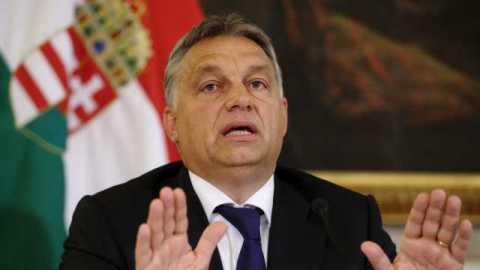
DUNABOGDANY, Hungary, Feb 2 (Reuters) - Setting a brisk pace, 79-year-old Peter Nogradi pounds the streets of a sleepy village by the Danube river each Wednesday, dropping a newsletter into mailboxes as part of a campaign by opponents of Hungary's Prime Minister ahead of April elections.
The simple A4 sheet, folded in two and printed in black-and-white, calls itself a weekly "newspaper" and features articles selected from websites by activists. It is distributed around Hungary by more than 1,300 volunteers with the aim of bringing news items to the attention of a rural audience, who organisers say can only access media loyal to the government.
The Feb. 1 edition in Nogradi's hands covers news about corruption, a teachers' strike for higher wages and the opposition's plans to cut VAT on basic foods if elected.
"This news does not appear in the mass media, you can only read it on the internet but not on all websites," he says.
Small villages where people mainly get their news from television or radio, and media channels controlled by the government, are traditional strongholds for Prime Minister Viktor Orban's Fidesz party. Orban, who rose to power 12 years ago with a landslide, faces a tight race for reelection on April 3 and media coverage plays a key role in his campaign.
In the freezing cold, the streets of Dunabogdany, north of Budapest, are empty. Nogradi, who worked as a software developer before he retired, says some are happy to pick up his leaflets, while others bin them right away but this does not put him off.
The leaflets, called Nyomtass Te Is! (You Should Print, Too!), are a non-party initiative that organisers have termed "21st century samizdat." Samizdat was the secret copying and distribution of banned literature during communist times. That Hungarians are resurrecting the tactic is a reflection of Orban's stranglehold over state and private media, say organisers.
The movement gathered pace in October after opposition leader Peter Marki-Zay endorsed it, saying he himself used to deliver the leaflets near his hometown.
"It is very important to balance out government propaganda with real news," Marki-Zay said.
A government spokesman said the Hungarian and international left had been using the issue of media as part of its political campaign "to discredit Hungary" for over a decade.
"The reality is that the diversity and balanced nature of Hungarian media is a bright spot compared to what we can see in Western Europe," Zoltan Kovacs told Reuters in emailed comments.
Marki-Zay, a 49-year-old Catholic conservative, father of seven, leads a six-party alliance against Orban and opinion polls show a tight race with Fidesz, which is just a few percentage points ahead.
By mid-January NTI had more than a thousand volunteers, up from about 150 in October, distributing about 150,000 copies during the last week of January, organisers said.
"We would need 3,500 people to reach the around 2 million people living in villages with 2,000 to 5,000 inhabitants," said Rita Bolla, a volunteer leader in Budapest.
"NEWS BUBBLE"
Orban has tightened his government's grip over state media, and also private media via ownership changes in the past decade. Advertising money channeled to pro-government outlets has also helped to create more loyal media coverage.
Dozens of newspapers, radio and television stations critical of Orban have changed hands, as businessmen close to Fidesz bought up media outlets. Some subsequently closed down -- like the country's leading daily newspaper Nepszabadsag -- while others quickly changed their tune.
The European Union and pro-democracy groups have long accused Orban's government of curbing media and other freedoms, a charge it has repeatedly denied.
In a February 2021 speech Orban said that Hungarian ownership in local media increased to 55% from 34%, which was one of the goals set out by his government in 2010.
Agnes Urban, an analyst at Mertek Media Monitor think-tank said the creation of a large conglomerate called the Central European Press and Media Foundation in 2018 by Orban loyalists, had allowed even greater government influence on the media.
It runs an immense media portfolio of more than 400 outlets, including all regional newspapers.
Urban said while Hungary still had a vibrant independent online news sector, many people, mostly in the countryside, lacked the media literacy to distinguish propaganda from news.
"It is very easy for them to get stuck in a news bubble [dominated by the pro-government media] and Fidesz makes sure to preserve this bubble."
In Dunabogdany, most people asked by Reuters did not want to be interviewed.
A 38-year-old woman, Judit, who did not want to give her family name, said she was aware of the self-printed newsletter. A mother of three, she had voted for the opposition in the past and will do the same when she casts her ballot on April 3.
"I am not really the target audience as I read news regularly anyway ... but I really respect the people who do this," she said.




